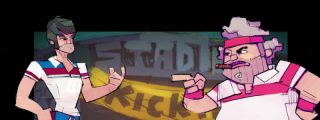When the Shadow Warrior remake came out in 2013, it quickly became a favorite of mine. As a fan of arena shooters, I had been starved for a while for good games to play. Wolfenstein the New Order was still months away (plus I didn’t even know about it if I’m frank), and Doom (2016) existed only in a place within my dreams. Shadow Warrior brought a fairly unknown game from the late 90’s in to the 2010’s kicking and screaming, refusing to change its core gameplay to conform with modern sensibilities. It kept the kinetic pacing, linear level structures, and focus on secrets. And it was awesome. It seemed that Flying Wild Hog had the easiest job in the world when it came to creating a sequel. Make more of the same, but bigger. They were not satisfied with that and instead Shadow Warrior 2 has moved in a direction that places a shooter-looter game scheme on top of the awesome, kinetic action that made the first one so great. Strap in, cause we are about to get into the weeds here.
The biggest change in Shadow Warrior 2 is that they have left the linear level design behind, favoring a more procedurally generated design instead. But I couldn’t tell this when I started the game, and in fact I didn’t actually notice the change for quite a while. This is because procedural generation here doesn’t really work like it does in other games. Shadow Warrior 2 doesn’t build the entire layout of the level procedurally, rather it selects from a set of rooms that it has in its memory and snaps them together with connecting spaces. It is closer to the system The Binding of Isaac uses than Diablo’s. Initially it works very well. The levels don’t feel randomized at all, and there is enough variety in the environment that things are exciting. But as you spend more and more time with the game, you will start to see the same rooms being repeated, and the illusion will fall away very quickly once you realize this.

A sense of repetition is exacerbated by the shoot ’em loot ’em mission structure the game has adopted. After you finish the initial levels, Shadow Warrior 2 drops you into a hub with stores, and NPC’s where you can find quests. There are two types of quests:side quests, which are worth doing as they can provide unique weapons and upgrades, and main quests, which move the game’s story forward. There are some critical story quests which will cancel all the side quests, and help the game move into separate arcs. Each side quest and story quest use their own separate levels, and are represented with a separate icon on their map, but side quests tend to recycle the tile sets (or room sets as it were) from the story quests, and some of these quests do require revisiting older levels. This means that after a while, it will start getting repetitive.
This design decision also caused some strange glitches, where chests and other collectibles would spawn inside of walls where they could not be reached. It has also allowed for strange instances where its easy for Wang to teleport into the environment like so:
This particular glitch took a full on re-load to be able to fix. Another user claimed that he had to teleport to another mission to fix it.
I have been criticizing the level generation a lot, but don’t get me wrong the game is fun, and while the levels get repetitive they can still be fun to explore. The levels tend to be fairly open, with several paths to navigating them that allow the player to take advantage of Wang’s mobility and invulnerability to fall damage to get creative in the way they choose to navigate them. There are secrets in each level with varying degrees of rewards for finding they might be just an upgrade competent for your weapon, or even a brand new weapon. There are also special boss monsters in most, if not all, quests that can be found and if defeated, they often drop unique weapons, unique skills, or legendary upgrades. All this means that despite the level design getting repetitive, its worth exploring them, and it can even be fun.

This was only after a few minutes of play
Shadow Warrior 2 features character levels, which are really just skill points. There are different upgrade trees, and as you progress through the game, you can find new and different skills to add to your repertoire. There are several trees, but you can choose any skill to level up at any time to suit your style. They go from improving the rate of drops, to combat skills. They sound like they add depth to the game, but the reality is that I didn’t feel their effect very much. I’d occasionally remember to allocate them, and find I have 15-20 points available. Shadow Warrior’s combat system is not an RPG system. It is the combat system of a twitch shooter, and so maxing out your skill might make some minuscule mathematical difference, but it won’t make a huge difference in your performance. This makes the skills basically a useless distraction, but considering the nature of the game, I prefer it that way.
Most of the loot you will get are upgrades for your weapons. Each weapon has three upgrade slots. These upgrades can attach elemental properties to guns, increase the critical chance and damage, or even do things like make Wang faster or more accurate. These upgrade are the bulk of the loot that you will find in this game. They come in different levels from normal, to rare, to legendary and everything in between. And you are going to get a lot of them. more than enough to greatly enhance your vast arsenal of weapons. There are so many, that they can become inconsequential really quickly. The game knows this, and about one third of the way into the game it will give you the option of crafting upgrades from your existing upgrades. The problem with this is that crafting upgrades costs money, and as you progress through the game, whatever it is that you crafted will be outclassed by whatever you pick up. Crafting also kind of slows this game to a crawl, and Shadow Warrior 2 is not a game that should slow down at all. The crafting is completely optional by virtue of being unnecessary, so you can skip it completely, but it makes you wonder why its there.

Yikes!
Shadow Warrior (2013) was an ugly game, and its sequel doesn’t go to great lengths to improve its aesthetics. This is particularly apparent in the character models and textures for the human NPC’s which feel like they belong in a game from the early 6th generation. The monsters and enemies do look better although while the game is in motion and you are fighting, you are most likely not going to be looking at them long enough to appreciate the design. The environments also look great, they are detailed, and varied, and they have a great weather system that can make some of these pre-made room or block sized tiles look very different. It is a shame that the procedural nature of the levels might make you tired of seeing them over and over.
So exactly is the plot this time around? Well, its very simple: Lo Wang once again gets involved in the machinations of gods, and he must now murder legions of demons, Yakuza, and robots, and cyberpunk super soldiers to save the day. There isn’t much more to it, and it doesn’t need to have more as it works fine to deliver the action. I have to say I was surprised as to how compelling the story could be at parts, and that was fueled mostly by some surprisingly good voice acting. But that’s not the tone of the vast majority of the game.

If you know Shadow Warrior you know its all about the Wang. Specifically, its about the humor that comes from its humorous and raunchy main character and the way he interacts with a story and characters that are otherwise played straight for the most part; as well as the way other characters react to him. I found the humor overall to be hit or miss. Some jokes just simply failed to land for me, but some of them were pretty funny. I can see people loving the humor of this game, so don’t let my personal sense of humor affect your decision.
I know a lot of the points made in this review are fairly negative, but the truth is that I enjoyed Shadow Warrior 2 quite a bit. That’s because its combat is incredibly fun. Shadow Warrior 2 is fast, kinetic, and bloody. It has an infinite dash, and it makes it extremely easy to switch from melee to ranged combat, so that you can dash in an out of melee range, changing weapons on the fly, and replenishing your health from the health packs thrown by your enemies. And with an enormous number of weapons, there are bound to be one that fits your play stay. Strong and slow with splash damage, high powered single shot weapons, fast rate of fire weapons, fast melee weapons with short range, big bone crunching melee weapons? Its all there and more. The Melee combat in Shadow Warrior 2 is some of the most satisfying melee combat in a first person game that I can remember playing. It is a mystery to me that the chose to add a parry button, which really involves you waiting to be attacked, and seems to be there only to wreck the delicate rhythm of the death ballet that is this game. The good news is you don’t really need to use this mechanic in the game, so its more like an additional tool in at your disposal instead of a game breaking change.

Waiting for Celebrity Guest Mel Gibson to finish the quest
Shadow Warrior 2 has an online cooperative multiplayer component that lets you clear the game with other players. I found the net-code to work very well. I had no issues with the servers and the connection was always very strong during my play. The host in the game has control over advancing anything, and in response the game will spawn more enemies, including more of the stronger enemies. Across the games you can keep the same Wang, which you can level up, and carry that even into New Game+ if you choose to start a new game. Sadly I wasn’t able to play it with a friend, I was only able to play with random players, but I can imagine the experience being greatly enhanced by playing with a friend.
It takes guts to try to mess with a winning formula, and credit goes to Flying Wild Hog for trying to make Shadow Warrior 2 into a slightly bigger version of the original. But the changes haven’t really improved the experience. There are two main draws to this game: the fantastic combat, and Wang being Wang. The procedural generation tends to make the levels unremarkable, the loot system slows the game down as you micromanage it, and the skill system is a pointless distraction at worst, or completely inconsequential at best. It has flaws. That being said if you are fan of fast-paced arena shooters and want something you can play by yourself or with friends, or if you want a thriftier alternative to Doom, I cannot recommend Shadow Warrior 2 enough.
This review was done on pre-release code provided by the publisher.






